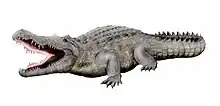Brachyuranochampsa
Brachyuranochampsa is an extinct genus of crocodilian.
| Brachyuranochampsa Temporal range: Middle Eocene, | |
|---|---|
| Scientific classification | |
| Domain: | Eukaryota |
| Kingdom: | Animalia |
| Phylum: | Chordata |
| Class: | Reptilia |
| Order: | Crocodilia |
| Genus: | †Brachyuranochampsa Zangerl, 1944 |
| Species | |
| |
The only robust occurrence of Brachyuranochampsa is B. eversolei from the Middle Eocene of Wyoming.[1] Another species, B. zangerli from the lower Bridger Formation at Grizzly Buttes, has been synonymized with another primitive crocodilian, "Crocodylus" affinis, also known from the Bridger Formation.[2][3]
Phylogenetic studies have consistently recovered Brachyuranochampsa as more basal than the crown group Crocodylidae, which consists of all extant (living) crocodiles.[2][4]
The below cladogram from a 2018 study combining morphological data and molecular DNA evidence shows the placement of Brachyuranochampsa within Crocodylia.[5]
| Crocodylia |
| ||||||||||||||||||||||||||||||||||||||||||||||||||||||||||||||||||||||||
References
- Zangerl, R. (1944). Brachyuranochampsa eversolei, gen. et sp. nov., a new crocodilian from the Washakie beds of Wyoming. Annals of Carnegie Museum, 30:77-84
- Brochu, C. A. (1997). "Morphology, fossils, divergence timing, and the phylogenetic relationships of Gavialis". Systematic Biology. 46 (3): 479–522. doi:10.1093/sysbio/46.3.479.
- Brochu, C. A. (2000). "Phylogenetic relationships and divergence timing of Crocodylus based on morphology and the fossil record". Copeia. 2000 (3): 657–673. doi:10.1643/0045-8511(2000)000[0657:pradto]2.0.co;2.
- Brochu, C. A.; Storrs, G. W. (2012). "A giant crocodile from the Plio-Pleistocene of Kenya, the phylogenetic relationships of Neogene African crocodylines, and the antiquity of Crocodylus in Africa". Journal of Vertebrate Paleontology. 32 (3): 587. doi:10.1080/02724634.2012.652324.
- Michael S. Y. Lee; Adam M. Yates (27 June 2018). "Tip-dating and homoplasy: reconciling the shallow molecular divergences of modern gharials with their long fossil". Proceedings of the Royal Society B. 285 (1881). doi:10.1098/rspb.2018.1071. PMC 6030529. PMID 30051855.
External links
This article is issued from Wikipedia. The text is licensed under Creative Commons - Attribution - Sharealike. Additional terms may apply for the media files.


